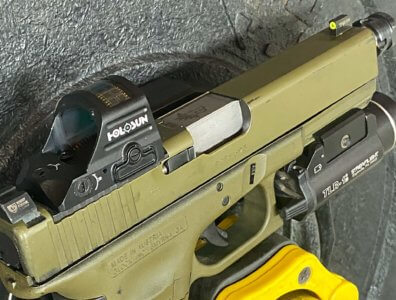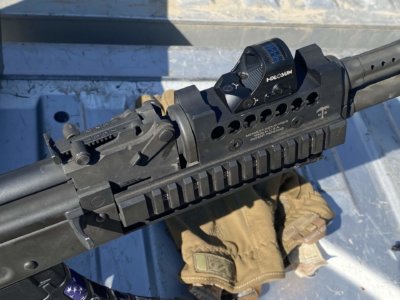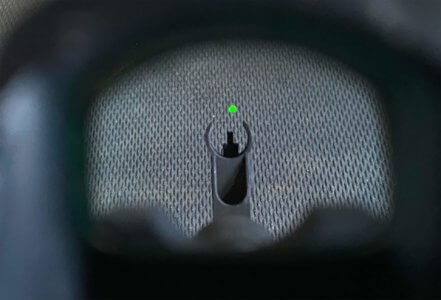Navigate This Post
Help us combat Censorship by joining our Newsletter
Despite the protestation of luddites, the optical sight on pistols is here to stay. Of the most popular models of pistol optic are those from Holosun. I have been using Holosun optics on pistols for 3 to 4 years now with great success.
Again, regardless of the opinions of naysayers, the optics from Holosun just keep getting better and better. Case in point, a new model that is a collaboration between Primary Arms and the Holosun company. The optic we will consider in detail is a version of the much lauded 507C.
Holosun HE507C-GR-X2 ACSS
As the cowboys might say, “That’s a five dollar handle if I ever heard one.” HE507C-GR-X2 breaks down the Holosun Electronics Model 507C, Green, Dual Reticle, with ACSSⓇ Vulcan™ sight. The Primary Arms ACSS “chevron” reticle is featured in bright green in this new optic and the end user can choose either the 10 MOA chevron alone or a chevron inside a 250 MOA circle.
Let’s consider the manufacturer’s specifications for a moment.
The Holosun HE507C-GR-X2-ACSS is a new generation of pistol red dot sight packed full of features like the multiple reticle system, solar failsafe, and shake awake technology to ensure your reflex sight is always operational when you need it. On top of the two battery-saving techniques, the HE507C-GR-X2 reflex sight features up to 20,000-hour battery life on setting 6 with the CR1632 battery. This battery is located in a convenient tray that slides out and allows you to easily change it without having to remove the optic from your pistol. This model features the revolutionary, patent-pending ACSS Vulcan reticle with an outer circle. It features 7075-T6 aluminum construction with an anodized black finish and fully multi coated glass for long-term durability that is backed by Holosun’s limited lifetime warranty.
One might ask, is this 507C solar-powered with a battery back up. Or, is it a battery-powered optic with a solar panel backup? The average battery life, with no solar panel assistance, is 20,000 hours. Considering there are 8760 hours in a year, you get 2.25 years of battery life. Can you afford to change batteries every two years? Yes, we are truly spoiled in our modern age.
Pistol or Rifle? Both?
The mounting footprint for the 507C is the same as a Trijicon RMR optic (not the new RMRcc). There are currently 5 popular mini/micro red dot footprints including the Leupold DeltaPoint, Burris Fastfire, Aimpoint Micro, Trijicon RMR and now the Shield/RMRcc. We could argue over which footprint is the most prevalent, but the RMR is the top of the list to be sure. Yes, there are more footprints, but most handgun manufacturers when making an “optic ready” slide are leaning toward either the RMR or RMRcc today.
I decided to test out the new 507C GR-X2 on my GLOCK17 Gen4 MOS (Modular Optic System). This particular G17 was already set up for an RMR so installing the 507C from Primary Arms was simple. At the range I discovered that the pistol was shooting about a foot high at 15 yards and I needed to crank the elevation way down. I suspect that this is due to the fact the GLOCK MOS pistols used mounting plates to allow the end user to choose a variety of red dot optics. The mounting plate raises the optic up as compared to affixing one directly to a pistol slide. Not to worry, after a half a dozen rounds I was on target shooting at a steel half-silhouette. After a few magazines, I pulled out my tool kit and switched the sight over to an AK rifle.
The particular AK in question had the original forend replaced by an aluminum rail system from Midwest Industries. The rail was cut and tapped to specifically accept the RMR. Now with the 507C on the rifle, I used the included tool to dial the reticle back up.
Once more, about a half-dozen rounds had me BZO’d at 25 yards with the AK. Now I went to work on the steel silhouette as well as Army surplus green plastic silhouettes. If you are waiting for me to tell you I had problems, keep waiting. With both the pistol and rifle it was smooth sailing.
Red vs. Green
Some might ask, why switch to green when we already had perfectly fine red dots reticles? Just like colored visible lasers, we have to deal with varied light conditions. The brighter the light, the more difficult it is to make out red lasers, and the same goes with dots. Bright sun tends to wash out red and we need to pump up the brightness on our red dots to compensate. The wash out effect is present with green, but to a lesser effect.
Also, partial or complete color blindness is a reality, particularly in a percentage of men. There are simply shooters who can perceive the bright green far better than they can red. Regardless of color-vision, we learned this lesson a long time ago with colored front sights. The bright “safety green” front sight is easier to pick up in all light conditions than an orange or red front sight.
Why Mount Optics on Pistols?
I find it rather amazing or perhaps dumbfounding that, after 20 years of evidence that shows our soldiers hit more bad guys when they use dot optics on their fighting rifles that we cannot see the translation to handgun. Let’s take a second to consider the physiological aspects of shooting under stress.
When threatened with danger, the natural response of the human animal is to visually focus on that threat (attacker). We know this, it is settled science. However, for a hundred years we have been teaching people to focus on their front sight, not the target. This works if there is no stress involved and/or the shooter has a high level of developed skill. When I say “high level” I mean thousands of hours of dedication.
We put bright front sights on handguns so that when the defender is focusing on the attacker and they index their handgun on said attacker, the bright front sight stands out in their view. The same goes for dot optics. The defender sees the threat, they index their weapon on the threat, but now there is a bright aiming indicator, whether red or green on or close to the threat. The appearance of a red or green dot on the threat is the “Go Code” for the shooter, letting them know that the muzzle is where it should be. Naturally, this all takes place in fractions of seconds.
Dot or Not?
Whether you decide to take advantage of mini dot optics on handguns, shotguns, or carbines is totally up to you. The products from Trijicon are rhino-tough, but they are also on the high end of the price spectrum. As mentioned at the outset, I have been using various Holosun optics for several years and not yet been disappointed. One average you will pay about half the cost for a Holosun than a Trijicon. If price is not a factor, go nuts.
Nonetheless, the bright green Vulcan reticle, the solar power panel, and the standard 20,000 hour battery life are all extremely attractive features. Hat tip to Primary Arms for their new product.
We’ve been long-time fans of Holosun and their various optics, and talked about them many times in articles and SOTG Radio. You can find one of those articles Right Here – AP5: Nakatomi Plaza Collection [Review]
Professor Paul Markel
Latest posts by Professor Paul Markel (see all)
- Tactical Masturbation: Top 3 Stupid Human Tricks - July 8th, 2024
- Blood Trail: Fearless Fiction - June 21st, 2024
- SOTG and SB Tactical Celebrate Brace Ruling - June 20th, 2024
- Shotgun Accessories: Practical and Useful - June 14th, 2024
- Tactical Rifle Tips: Transition Drills - January 5th, 2024









I see the clear benefits of red and green optics. I would say though, since most gunfights are three or four yards (average conversational distances) I see great difficulty, in having enough time, and distance to getting your red dot on target and your eyes acquiring it. Seems at that average gunfight distances you point and shoot. Beyond seven yards, yes, I think you can bring the pistol and red or green optic to eye level successfully.